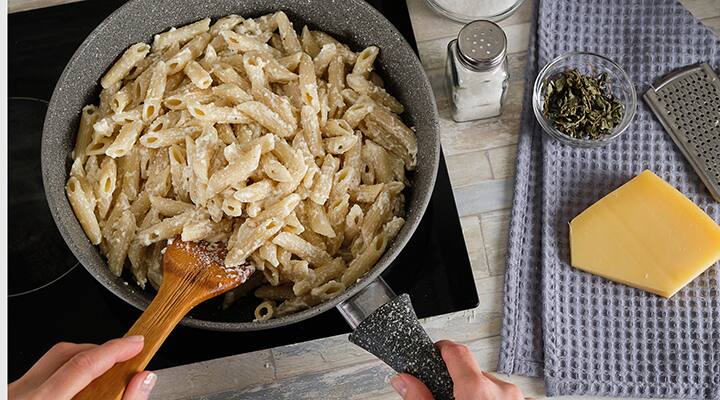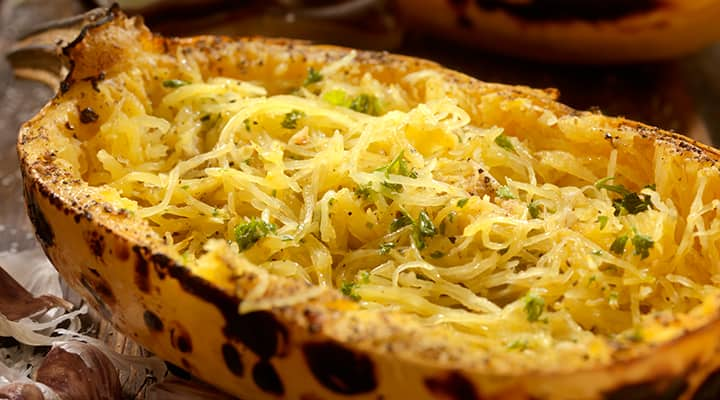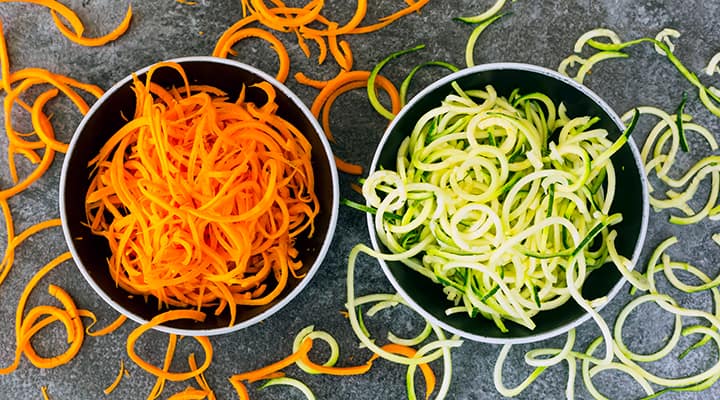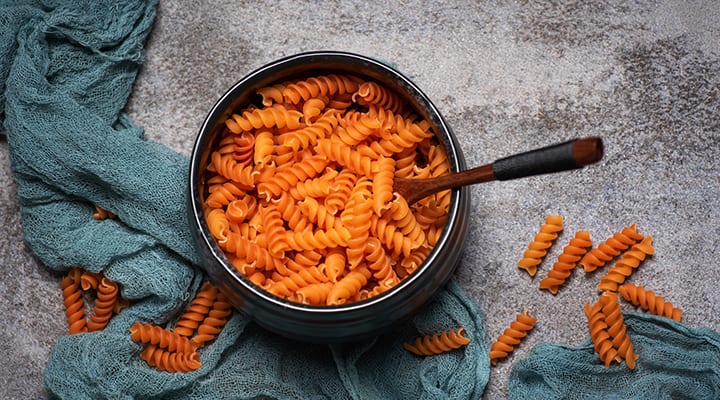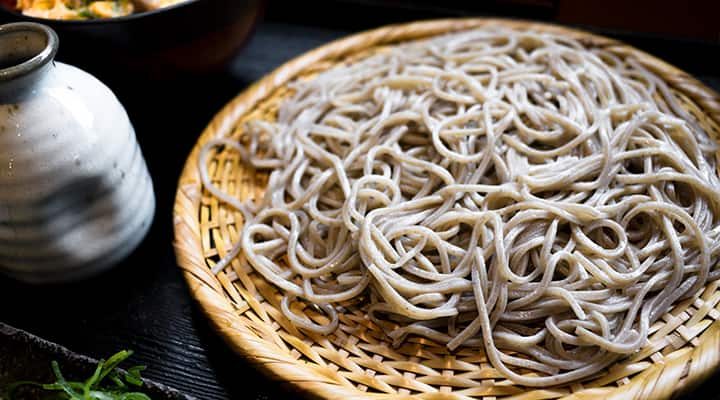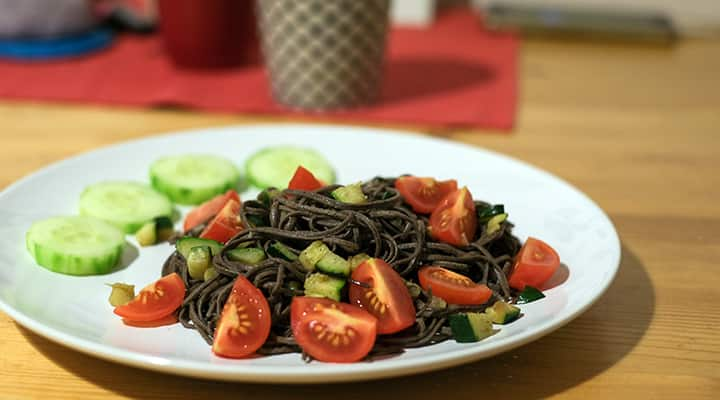
14 Best Pasta Alternatives: Buying Guide
Published: November 2022
If you love pasta but want to keep it healthy, the good news is that more kinds of pasta than ever are made from whole grains—or even no grains! Similarly to the burgeoning trend of plant-based milks, the vegetable-based "alternative" pasta category has seen major growth over the past decade, coinciding with the popularity of low-carb diets.
Of course, the even better news is that traditional pasta is not as unhealthy as you may think. Especially if we eat it in the right amounts and pair it with healthy ingredients.
It can be overwhelming to navigate today's abundance of options. Let's look at some of the different types to help you determine which may be best for your needs. We'll also explore some nutrition facts about the traditional noodles we know and love. Whether you go against the grain with a pasta alternative or stick with the "OG" pasta, there are healthy options abound!
What is traditional pasta?
Pasta is a staple in areas surrounding the Mediterranean, a region known for good health and longer life, and is popular in many other areas of the world such as right here in the U.S. Pasta is traditionally made from semolina, an enriched durum wheat flour, which has more nutrients than, say, a refined white bread flour (even though the wheat germ and bran have been removed). One thing to keep in mind is that while traditional dry pastas in the United States are enriched with iron, riboflavin, thiamine, and folic acid, most alternative pastas aren't.
Does pasta make me gain weight?
Pasta is sometimes referred to as "fattening," high-carb, or a source of empty calories. However, pasta can be a part of a healthy eating pattern. One issue is that when it comes to grain-based foods, whether it be pasta, rice, bread or cereal, we tend to eat more than we should. The standard serving size for traditional pasta is 2 oz, dry. If you eat double or triple that, just as if you ate double servings of any other calorie-dense food, sure, it can add up!
Additionally, pasta is usually paired with unhealthy sauces, and served in large portion sizes. Although pasta itself is low in fat, saturated fat-laden pasta dishes like mac and cheese, fettuccine alfredo, or spaghetti and meatballs may have given pasta a bad name. Cheese sauces or meatballs add protein, but are high in calories and saturated fat. Pasta with marinara sauce, made with lycopene-rich tomatoes, is a healthy option, as is pasta with garlic and olive oil, with or without herbs like basil or vegetables such as broccoli.
Additionally, let's keep in mind that despite its high carbohydrate content, traditional wheat-based pasta has a relatively low glycemic index (GI), averaging less than 55 compared to glucose, which has a GI of 100. Because of its lower glycemic index, consuming traditional pasta is less likely to result in blood sugar spikes when compared to higher GI foods. Also, traditional pasta contains 2.5 grams or more fiber per 2-ounce dry serving. Fiber can help blunt the effect of carbs in the bloodstream.
Pro tip: Looking for an excuse to buy that pasta attachment for your kitchen aid mixer? Due to the displacement of some of the flour by the eggs, fresh pasta is lower in carbohydrates than store bought dried pasta!
Is Gluten-Free Pasta Better than Traditional Pasta? Myth & Facts
Although people with celiac disease must abstain from foods that contain gluten, it is a myth that a gluten-free diet is necessarily healthier. However, gluten-free pasta made from brown rice, quinoa, lentils or garbanzo beans may have more protein, fiber or other nutrients than regular pasta, which makes them nutritionally better.
Spiralized squash or zucchini make delicious alternatives to dried pasta made from grains and are 100% gluten and grain-free. Look for these in the produce section of your supermarket, or buy your own spiralizer to make fresh vegetable "pasta".
Low-carb pasta alternatives
According to a recent article published in The International Journal of Food Science, "Increased demand by growing number of health-conscious consumers for healthy foods has shifted the interest of researchers and food manufacturers to develop pasta products rich in minerals, vitamins, fiber, and with low glycemic index."
So what are these new-fangled pasta products? Let's explore the options—some of which are actually just straight up vegetables in a noodle-like form and the others are actually sold in boxes and need to be boiled in water. When it comes to texture, be forewarned that there are some differences compared to the high gluten noodles we are accustomed to. For example, I've found that rice and chickpea pasta is delicate and may become soggy after cooking. Whereas red lentil pasta could be firm and more similar to that al-dente texture many aim for with pasta noodles.
Notably, the benefits of the vegetable and legumes discussed here mainly apply to the food itself, but not necessarily its noodle derivative. Some nutrients may be lost during processing. More head-to-head studies are needed to examine the nutritional impact of substituting vegetable-based pastas for traditional durum wheat pastas.
14 Healthy Pasta Alternatives
1. Shirataki (konjac) noodles
These "miracle noodles" pique the interest of health-conscious consumers because they are very low in calories. Shirataki noodles are made from the konjac yam, a root vegetable that contains a dietary fiber called glucomannan which can help support heart health, blood sugar, and weight management.
2. Spaghetti squash
A scooped spaghetti squash with a nice tomato-based sauce and shredded cheese is the "OG" pasta alternative! This winter squash, like pumpkin, is a source of carotenoids, vitamins C and B6, fiber, magnesium, and potassium. It is also a low glycemic index food.
3. Kelp noodles
Do you start your sushi date with seaweed salad? Seaweed salad may include more than one type of algae such as kelp or wakame. Seaweed based foods are commonly enjoyed in Japanese cuisine and are associated with the longevity seen in Japanese populations – in fact, Japan has the highest proportion of centenarians (100+ years old)! A clinical trial of 5,777 Korean adults aged 40-69 years old who consumed laver, a type of seaweed, maintained their metabolic health.
4. Spiralized vegetables
You can make your own spiralized noodles at home using a spiralizer or you buy them from your local grocery store. Zucchini and butternut squash are popular options. Zucchini noodles (sometimes called "zoodles") are high in fiber and help support healthy digestion and blood sugar. Zucchini is also high in antioxidants and a low carbohydrate alternative to grain or legume-based noodles.
5. Mung bean noodles
Mung beans in general have a variety of health benefits due to their impressive nutrient profile. Mung beans have been found to help support a healthy heart, blood sugar, and immune health. A clinical trial in 18 healthy adults found that those who ate mung bean noodles exhibited a low metabolic response (meaning they maintained healthy blood sugar levels).
6. Red lentil pasta
Pasta made from lentils is one of the newer alternative pasta options on the scene. Lentils are rich in polyphenols with health-promoting properties ranging from helping support healthy blood sugar, weight management, lipid profiles, and a healthy inflammatory response. I once made a lasagna using lentil pasta sheets and it was great!
7. Chickpea pasta
Chickpeas, also called garbanzo beans, are a nutritious legume that also contain bioactives with antioxidant properties. Consumers of chickpeas have been shown to have higher nutrient intakes of dietary fiber, PUFAs, vitamin A, vitamin E, vitamin C, folate, magnesium, potassium, and iron compared to those who don't eat this versatile food. Further research suggests that chickpeas can help contribute to weight management and support healthy glucose/insulin levels.
8. Quinoa pasta
Although technically a seed, quinoa is also grouped into the whole grain category. It is versatile and can be included in sweet or savory dishes. Quinoa has a high amount of essential fatty acids, vitamins, minerals, and fiber. You may find a blend of quinoa and corn when locating this type of noodle in the pasta aisle.
9. Palmini (hearts of palm)
Not only is this vegetable low in calories and carbs, hearts of palm also offer a healthy nutrient profile including vitamins, minerals, and fiber. You can find these inner parts of palm trees transformed into linguine in the pasta aisle!
10. Sweet potato noodles (aka, "glass noodles")
You may have seen these as a base option offered at your favorite healthy build-a-bowl restaurant. Orange sweet potatoes are particularly high in vitamin A. Although in potato form, they tend to be high in carbohydrates, they are still beneficial to our health.
11. Buckwheat (soba) noodles
Despite having "wheat" in the name, buckwheat noodles (like many of the pasta alternatives discussed here) are gluten-free. Buckwheat contains a variety of phenolic compounds, such as quercetin, with antioxidant properties. Buckwheat noodles are also a good source of potassium, phosphorus, and magnesium. Health benefits of buckwheat include supporting healthy cholesterol and blood sugar as well as a healthy inflammatory response. Try this Sesame Buckwheat Noodle recipe!
12. Brown rice pasta
Noodles made from brown rice were one of the first wheat flour alternatives available on the market in the earlier days of pasta alternatives. They go with just about any sauce.
13. Cauliflower or potato gnocchi
Gnocchi is a pasta dumpling traditionally made from potato, egg, and wheat flour. A gluten-free version can be made with cauliflower, potato starch, and cassava flour. Or you can use wheat flower and make it with cauliflower to up your cruciferous veggie intake. Cauliflower is a cruciferous vegetable and comes with a great nutrient profile providing important nutrients like the isothiocyanate sulforaphane. Along with its role in supporting healthy cell division (helping to protect against cancer), cauliflower also supports heart, metabolic and brain health. And, the flower-like shaped vegetable supports a healthy inflammatory response and protects against oxidative stress.
14. Black bean pasta
In general, beans have a variety of nutritional benefits and inclusion of beans as part of a plant-based diet strategy can help support heart and metabolic function as well as weight management and healthy inflammatory responses. Although black beans have carbohydrates, their high fiber content results in lower net carbs. Some health benefits of beans include decreased body weight and waist circumference; decreased cholesterol, triglycerides, and blood pressure; and support of healthy blood sugar and glucose parameters. A study of 246 women found that those who consumed moderate or high amounts of beans had less body fat and smaller waists than those with low intakes of beans. Further, those with higher adherence to a bean-based dietary pattern had lower body fat % and larger waist circumference than those with low consumption, who had high body fat % and waist circumference.
How to choose a pasta alternative
So which pasta alternative is healthiest? The good news is that all of these options, as well as traditional and whole grain pastas enjoyed in moderation, are nutritious and delicious! Give them each a try and discover which one you like best.
References
- Bielefeld D, Grafenauer S, Rangan A. "The Effects of Legume Consumption on Markers of Glycaemic Control in Individuals with and without Diabetes Mellitus: A Systematic Literature Review of Randomised Controlled Trials." Nutrients. July 2020. https://www.ncbi.nlm.nih.gov/pmc/articles/PMC7400945/
- Devaraj RD, Reddy CK, Xu B. "Health-promoting effects of konjac glucomannan and its practical applications: A critical review." Int J Biol Macromol. April 2019. https://pubmed.ncbi.nlm.nih.gov/30586587/
- Ganesan K, Xu B. "Polyphenol-Rich Lentils and Their Health Promoting Effects." Int J Mol Sci. November 2017. https://pubmed.ncbi.nlm.nih.gov/29125587/
- Hou D, et al. "Mung Bean (Vigna radiata L.): Bioactive Polyphenols, Polysaccharides, Peptides, and Health Benefits." Nutrients. May 2019. https://www.ncbi.nlm.nih.gov/pmc/articles/PMC6627095/
- Park H, Lee KW, Shin D. "Association of Seaweed Consumption with Metabolic Syndrome and Its Components: Findings from the Korean Genome and Epidemiology Study." Foods. June 2022. https://www.ncbi.nlm.nih.gov/pmc/articles/PMC9180172/
- Wallace TC, Murray R, Zelman KM. "The Nutritional Value and Health Benefits of Chickpeas and Hummus." Nutrients. November 2016. https://pubmed.ncbi.nlm.nih.gov/27916819/
- "Isothiocyanates." Oregon State University. https://lpi.oregonstate.edu/mic/dietary-factors/phytochemicals/isothiocyanates
- "Pasta Table." Today'sDietitian. https://www.todaysdietitian.com/newarchives/images/pdf/Pasta_Table.pdf
- "Winter Squash." Harvard T.H. Chan School of Public Health. https://www.hsph.harvard.edu/nutritionsource/food-features/winter-squash/

